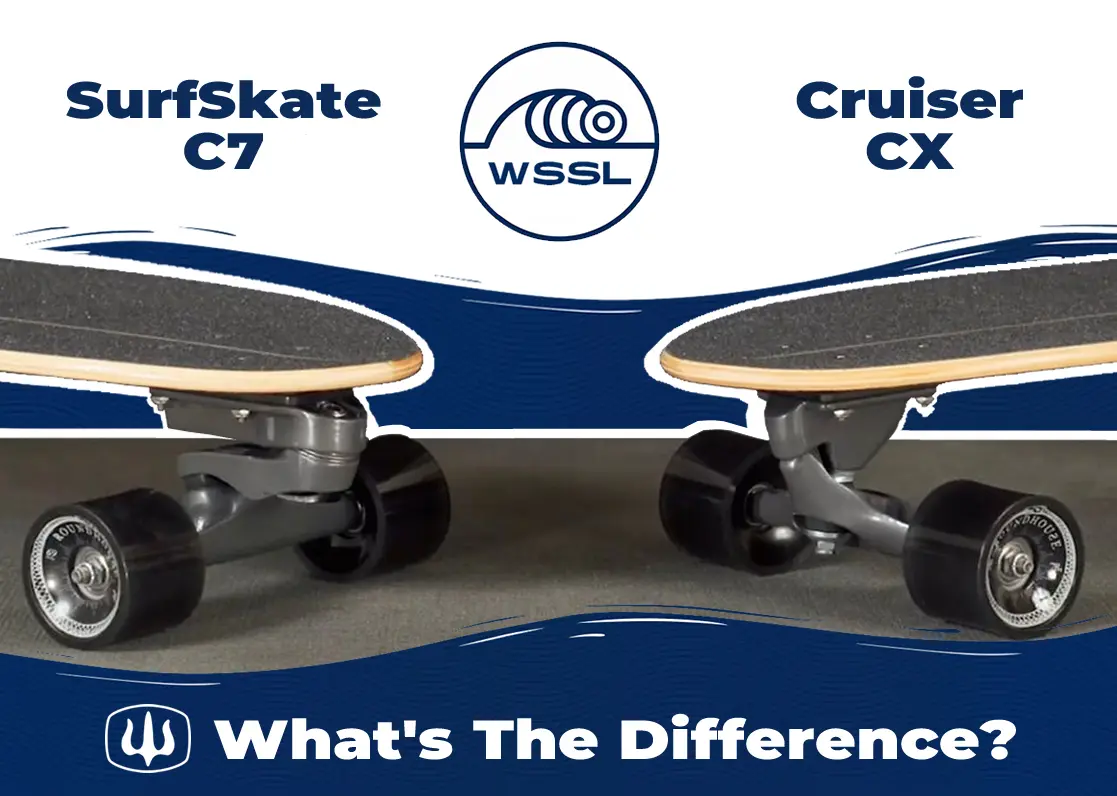
Cruiser vs SurfSkate
- Categories Blog
- Date July 16, 2024
What are the main differences between Cruiser vs SurfSkate?
We are approaching 2024, and many people still haven’t grasped that there are significant differences between skateboard Cruiser and SurfSimulator.
Maybe the main reason is a lack of information, naivety on the part of the manufacturers themselves, or even the intentional decision not to differentiate between both modalities, as in terms of market reach, this can be considered the best strategy.
Based on my experience of over 10 years as a dedicated athlete in the new SurfSkate modality, I will provide you with a detailed explanation of the main characteristics that differentiate SurfSkate from the Cruiser lifestyle.
First and foremost, fundamentally, you need to understand that there are two pillars among flexible trucks, namely: Stability / Steering.
The stiffer the front truck is, the More STABILITY and Less STEERING you will have.
The more flexible the front truck is, the Less STABILITY and More STEERING you will have.
With that said, let’s now understand structurally the other characteristics of the equipment, usage, and finally, a brief definition about SurfSimulator.
Topics Of Article
Characteristics Of The Cruiser Skateboards:
- The decks are wide and can come in various sizes, ranging from 25” to 37”, to provide more stability.
- The front truck is equipped with soft bushings for impact absorption on uneven surfaces.
- Large and soft wheels to provide more speed and cushioning on various types of terrain.
- Features a kick-tail, allowing the athlete to easily go up and/or down curbs.
- Smooth concave for added comfort to the athlete.
- Lightweight for easy transportation and agility while riding.
In general, the main features and design of cruiser skateboards prioritize comfort, satisfaction, and the ability to navigate smoothly over long distances.
Use Cases For Cruiser Skateboards
Cruisers are perfect for skateboarders seeking a recreational experience or a pleasant mode of transportation to explore new places freely.
The Cruiser, due to its stability and less aggressive turns, is also popularly known as a confidence-building tool for athletes having their first experiences in skateboarding and who intend to transition to another modality, SurfSkate.
The shorter wheelbase and narrow trucks make Cruiser skateboards agile, enabling athletes to navigate easily through busy streets and winding sidewalks.
These characteristics also make the Cruiser an excellent choice for commuting, as it easily allows maneuvering in traffic and quick, relaxed rides over medium-distance routes.

Characteristics of the SurfSimulator:
- The decks have shapes similar to surfboards, and their sizes range from 29” to 41”.
- The front truck has a flexible system using a spring to provide elastic potential to athletes.
- Medium-sized and density wheels to provide acceleration and efficiency in maneuver execution.
- Have a kick-tail and steep concave to assist in maneuver projection.
In general, the main characteristics and design of the surf simulator were designed so that the athlete can express the maximum similarity to surfing.
Use Cases For SurfSimulator
The surfsimulator was built in 1996 by the Carver Skateboards brand from the USA with the recreational purpose of providing enthusiasts with sensations similar to surfing.
In 2012, I and a few others athletes around the world had the audacity to perform high-performance maneuvers on concrete waves while riding the surfsimulator.
In 2014, I organized several in-person events aiming to endorse this new SurfSkate modality.
Only in June 2017 did I have the brilliant idea of establishing the first International SurfSkate Regulations through the WSSL – World SurfSkate League, officially formalizing the emergence of this new sports modality called SurfSkate.
So, the prerogative of SurfSkate is to ‘Express, through a SurfSimulator, the maximum reality of surfing.
A Brief Definition About SurfSimulator
I had to clarify all this information just so that you definitively understand that the ideal SurfSkate equipment to express the maximum reality of surfing needs to be highly responsive and capable of making sharp turns.
That said, only a front truck with a flexible system using a spring, due to the favored elastic potential, is genuinely considered a SurfSimulator.
Rafael Azevêdo pioneered SurfSkate and developed this new authentic modality in 2014 through hosting championships and social events in Brazil.
He built the legend StreetStyle SurfSkate Park and established the key criteria through WSSL to globally regulate the new surfskate modality.
Full-stack professional in Marketing and Technology, SurfSkate Coach, Content Producer, and CEO of the World SurfSkate League.
You may also like

The History Of Genuine SurfSkate




